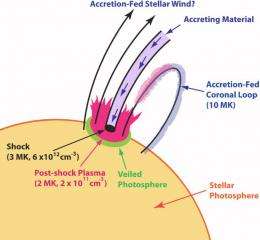X-Ray Emission from Young Stars

(PhysOrg.com) -- The star TW Hydrae is located about 150 light-years from earth in the direction of the constellation of Hydrae, the Water Snake. This star is relatively young -- at about 10 million years old it has passed out of its infancy but is not yet mature.
Astronomers are trying to understand the processes at work around stars at this stage in their lives, when planets might be developing from disks around them, and TW Hydrae is a valuable example for two reasons: it is relatively close by and therefore bright, and it is rotating with its pole pointed nearly directly towards earth, enabling scientists to view the star's surrounding disk of material nearly face on.
Like other young stars of its size and age, TW Hydrae emits strong X-rays. The question is why, and how might they effect the star's proto-planetary disk? Several mechanisms have been proposed, including coronal magnetic field activity similar to that on the sun, accretion onto the stellar surface that might also contribute to winds and flares, and shocks from jets that develop. Each mechanism has associated with it hot gas with characteristic temperatures and densities.
SAO astronomers Nancy Brickhouse, Steve Cranmer, Andrea Dupree, Juan Luna, and Scott Wolk used the High Energy Transmission Grating on the Chandra X-ray Observatory to obtain the most detailed X-ray spectra of this star ever seen.
They measure and model forty-two emission lines from gas present at extremely high temperatures, ranging from between about 2 million to 10 million degrees kelvin. Their results show that the star has both a hot solar-like corona and an accretion shock at relatively high densities and small volumes.
Interestingly, the shocked gas heats a larger volume of the stellar atmosphere up to 2 million degrees, much hotter than the 10,000 degree hot spots previously known from optical and ultraviolet spectra. The new results are able to explain many of the earlier puzzles associated with X-ray emission, help to identify how winds can be produced in these stars, and suggest that the magnetic processes at work in this star are by no means unique but may be ubiquitous in other young stars of similar mass.
Provided by Harvard-Smithsonian Center for Astrophysics


















